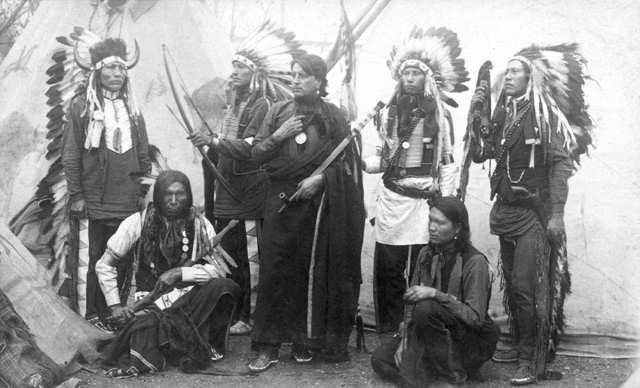

| Home Links Contact |
| 1887-88 1891-92 1892 1902-03 1904 |
|
|

Wild West Indians in London, 1887
(Red Shirt is the central figure)
Buffalo Bill’s Wild West sailed out of New York on board the SS State of Nebraska on Thursday, 31st March 1887, docking at Gravesend, Kent, on the afternoon of Thursday, 14th April. Colonel Cody thence proceeded directly to London, while the rest of the company sailed up the Thames, disembarking at the Royal Albert Dock on the following morning, Friday, 15th.The venue was Earl’s Court, where Buffalo Bill’s inaugural transatlantic season would run as an adjunct to the American Exhibition, organised as part of the celebrations for Queen Victoria’s Golden Jubilee year. William Ewart Gladstone, four times British Prime Minister but currently Leader of the Opposition, visited the Wild West camp on Monday, 25th April.
On Thursday, 5th May, the Prince of Wales, the future King Edward VII, watched a preview of the show, prior to its opening to the general public on Monday, 9th May 1887. A Royal Command Performance was held in the presence of Queen Victoria on Wednesday, 11th.
The official programme lists the surprisingly high total of 104 Indians. Their names are given in both English and Lakota (although the native language is not identified as such) and only adult males appear to be included. Red Shirt, the ‘Chief of the Sioux Nation’, leads the roster, presented in six roughly equal subdivisions, each assigned a ‘chief’, as follows: Cut off Band of Sioux (20), Araphoes (16), Cheyennes (17), Brule Sioux (18), Shoshones (15) and Ogalallas (17). These tribal affiliations are, for the most part, fictitious; it was a perennial feature of Buffalo Bill’s Wild West that it contrived to create the impression that a greater number and far broader spectrum of tribal identites was represented than was actually the case.
A further Royal Command Performance was held on the morning of Monday, 20th June 1887, the fiftieth anniversary of Queen Victoria’s accession. The venue on this occasion was Windsor Castle and the audience was made up of Her Majesty’s distinguished guests, who had gathered to attend the Golden Jubilee ceremonials. This is the event so graphically described by Black Elk.
Red Penny, aged just eighteen months, the infant son of Little Chief, was the first of two 1887 Lakota fatalities. He died of convulsions at the Wild West camp, West Brompton, London, on 15th August 1887. The informant was Broncho Bill Irving; the deceased was interred in Brompton Cemetery, London.
After the Earl’s Court run ended on Monday, 31st October, performers and spectators alike shivered through just short of four weeks of outdoor performances at the Aston Lower Grounds, Birmingham, from Saturday, 5th November until Thursday, 1st December.
Not long after moving north, Surrounded, aged 22, died of pneumonia at the Salford Union Infirmary, Pendleton, on 14th December. Once again, Broncho Bill Irving acted as informant and this latest casualty joined Red Penny in Brompton Cemetery on the following day, the 15th.
Three days later, the Salford run began on Saturday, 17th December 1887. The historical pageant, The Drama of Civilization, first unveiled the previous winter at Madison Square Garden, New York City, was revived for a lengthy winter season in specially constructed indoor premises at the Manchester Racecourse, Salford.
Programme Insert, Salford, 1887-88Little Chief and his wife Good Robe were in some measure compensated by the birth of a daughter, Frances Victoria Alexandra, at the Wild West camp during the early hours of Wednesday, 8th February 1888. The child was baptised at St Clement’s Church, Salford, a week later, on Wednesday, 15th.
The Salford stand concluded with a programme of outdoor sports on Tuesday, 1st May 1888, the main feature of which was a horse race in which Antonio Esquivel competed against a local rider named Latham. Following an inconclusive outcome, the race was re-run on Thursday, 3rd.
As the show left Salford on the morning of Friday, 4th, however, four of the Indians failed to answer roll call.
The final engagement of the season was a single performance at the football ground, Holderness Road, Hull, on the afternoon of Saturday, 5th, before the company set sail on the Persian Monarch in the early hours of the following day, Sunday, 6th.
A considerable number of Indians had left the show in mid-season, returning home early on account of various illnesses and injuries. Forty-eight of those remaining now travelled in steerage, among their number two women and three boys aged four, fourteen and sixteen respectively. Travelling as Intermediate passengers were Red Shirt; John Y. Nelson’s Lakota wife, Jenny (otherwise Yellow Elk Woman), and mixed-blood children Julia, Tommy, Jimmy and Rosa; as well Broncho Bill Irving’s Indian wife, Ella, with mixed-blood children Benny, Billy and Lizzie. Another Intermediate passenger, Siss Bissnett, was probably another mixed-blood.
Nothing more, however, had been heard from the four Salford absentees. Evidently oblivious to the fact that they had almost forty-eight hours in which to make their way to Hull, Black Elk and his three companions, all adult males, had still not appeared when the ship set sail. After a series of misadventures in England and on the continent, all made their eventual and separate returns to South Dakota.
On Sunday, 20th May 1888, the Persian Monarch discharged its passengers directly onto Staten Island, New York City, in preparation for a lengthy stand at Erastina.